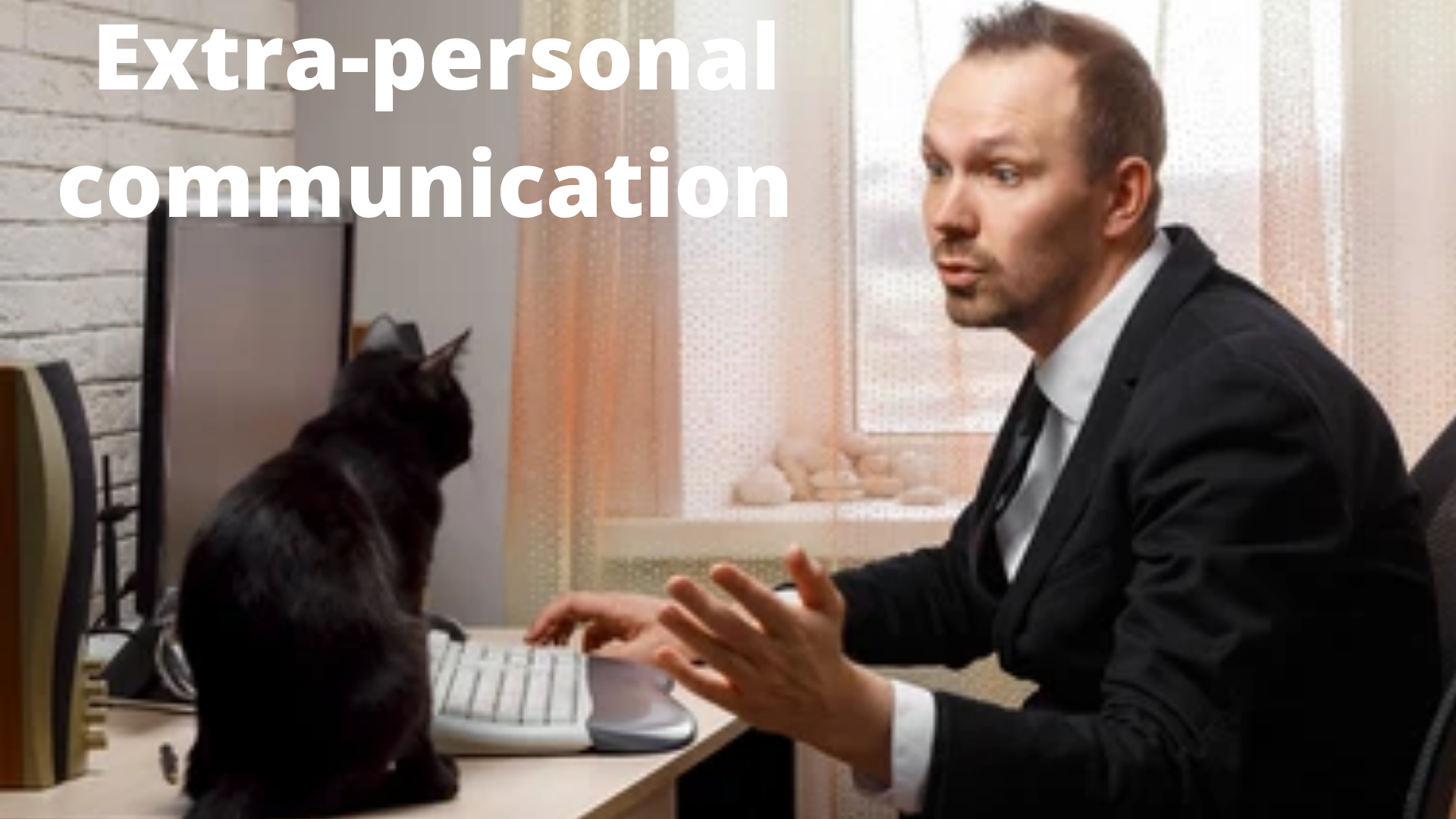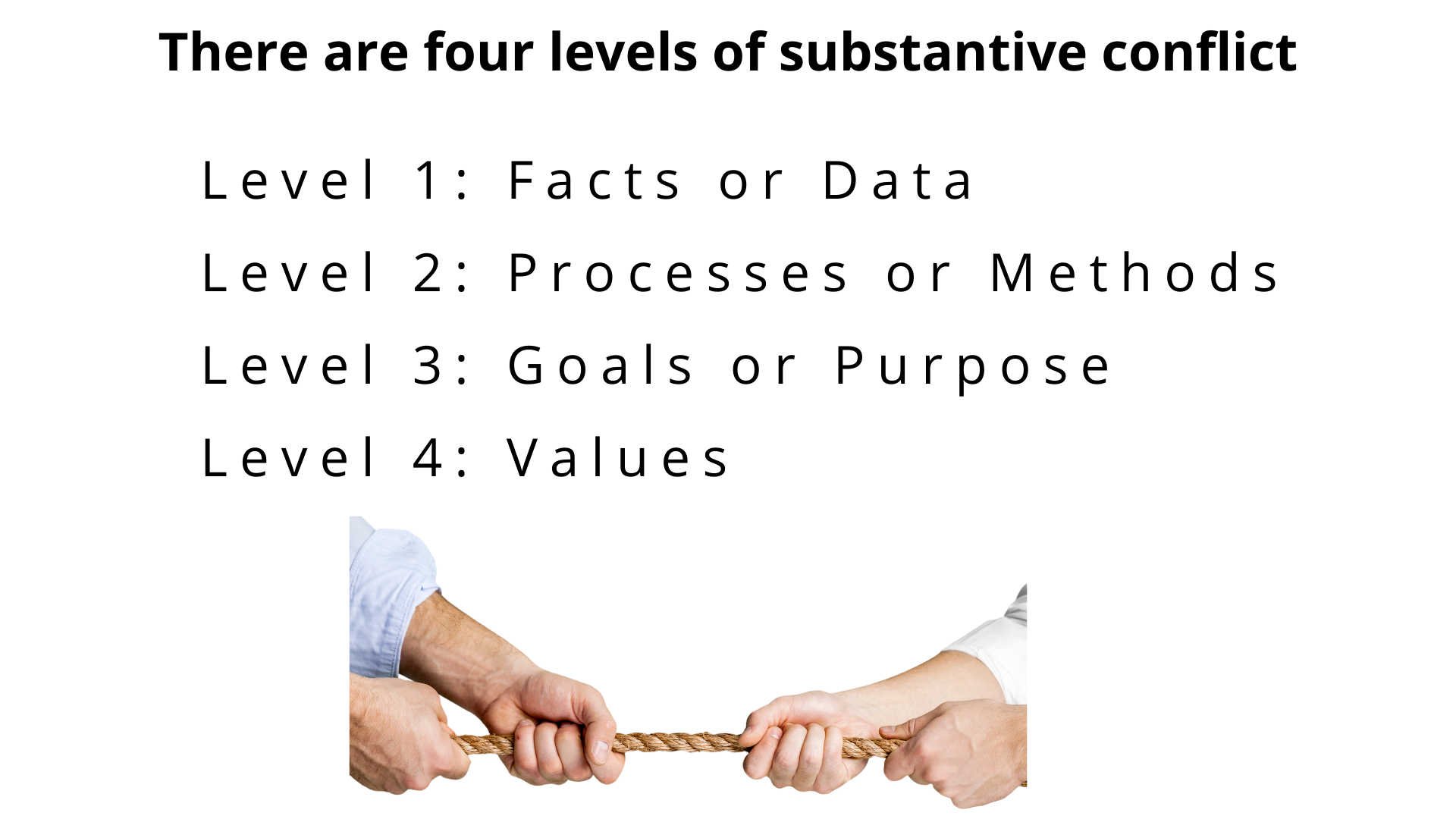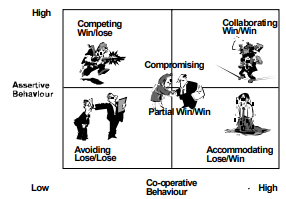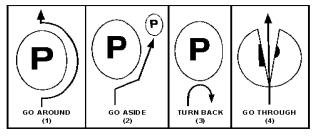Verbal Communication
The communication process takes place when information sent by a person (the sender) is received by a second person(s) (the receiver), decoded and reacted upon.

Effective communication only takes place when the reaction of the receiving person is positive, according to the expectations of the sender. For example, by altering the intonation of the voice a customer may either receive the message that a waiter is really pleased to see and help him or that he is merely another nuisance to be served. Effective internal and external verbal communication has a direct effect on a company’s image and success in the following ways:
- Good, clear, concise communication eliminates time wastage in trying to resolve confusion, errors and conflicts.
- Customers/guests/patrons like feeling important and will return and recommend the establishment to others if they are treated with politeness and helpfulness. This promotes return business.
Staff with positive attitudes, who speak to each other with respect, reflect a positive company image. This gains customer confidence in the establishment.
Types of Verbal Communication
Internal
Internal verbal communication may be categorised as follows:
Intra-personal communication is communication with one’s self. Talking to one’s self is an example.
Extra-personal communication (as illustrated above) refers to communication to an inanimate object or non-human (plant or animal). For example, talking to a cat/dog or saying: “You naughty table!” after a toddler bumps his head on it.
Interpersonal communication refers to an ordinary conversation on a one-on-one basis, or a very small group. It may also refer to communication between groups of individuals (group discussions or informally in a crowd). For example, communication within and between departments in an organisation.
The experience in business has been that, generally, as the size of the organisation increases, communication decreases and morale declines. The ever-increasing size of organisations means that lines of communication are further and further extended. The more communication “centres” (e.g. departments within an organisation) a message has to pass through, the greater the chance of distortion or breakdown.
Instead of trying to improve communication abilities of all employees, there are steps that may be taken to alleviate the situation:
- Open channels for feedback should be established.
- Policy and procedure for communication should be laid down.
- Top management should communicate directly to all staff using the public-address system or public notice.
External
This refers to communication with an audience or people outside of an organisation.
For example: Suppliers, Cleaning Services, and Out-sourced Facilitators conducting lectures in a corporation.
Face-to-Face
When communicating face-to-face, body language plays a vital role in conveying the appropriate messages.
Eye Contact
In the business culture, it is imperative to make eye contact if one wishes to make a positive impression with guests and maintain a relationship based on trust. Consider the following:
- Maintain eye contact without staring, as this is arrogant and threatening.
- Avoid blinking too much as this communicates nervousness and can be interpreted as an indication of dishonesty.
- Try to keep eye level on the same level as the guest. Stand if the guest is standing. If the guest is seated, accommodate this by standing back a little.
Facial Expressions
Be aware of facial expressions when speaking to people. Professional service providers who deliver excellent service have alert, lively and appropriate facial expressions. Avoid the following facial expressions:
- An expressionless or deadpan face showing no emotion in response to what guests say makes them feel uncomfortable. This may be interpreted as boredom, rudeness or indifference.
- An arrogant or stern expression creates the impression of being superior to others.
- Grinning continually makes one look stupid. It creates the impression of misunderstanding what is being said or done. It may also create the impression of being deliberately unhelpful.
Gestures
Head and hand movements are common during speech: Smooth and wide gestures with palms facing upwards, are warm and welcoming. People react positively to friendliness and helpfulness. Guests are naturally drawn to people who use calming gestures.
Sharp, short gestures with palms facing downwards, are aggressive and negative. People react by wanting to either dispute or avoid. When upset or if there is a need to discuss problems, gestures should be controlled. Problems are never resolved through aggressive gestures.
Posture
The way the speaker stands, sits or walks, indicates a great deal about the speaker’s attitude, mood and self-esteem. A correct posture entails the following:
- Stand upright with arms comfortably at sides
- Keep shoulders dropped and slightly back
- Stand with feet slightly apart to maintain balance
- Walk briskly because it creates a professional impression
- Sit upright with shoulders back. Slouching looks lazy
- When speaking to guests, either face them or turn the body slightly sideways towards them
- Avoid leaning against walls or furniture
- Avoid folded arms – they create the impression of being shy or arrogant
- Standing with hands on hips looks arrogant
- Swinging when speaking to people suggests a lack of self-confidence
- Resting the face on hands while leaning on counters looks lazy.
Personal Space
This refers to the space each person has around him/her and into which intrusions are unwelcome. The exact size of the area around each person differs and depends on a variety of factors including, personality, culture, family background and even the type of sport played. Shy people usually need a wider personal space than outgoing people do. People instinctively indicate when their space is invaded - they either move away slightly, look uncomfortable, blink their eyes to show their discomfort, or look behind the speaker to avoid eye contact.
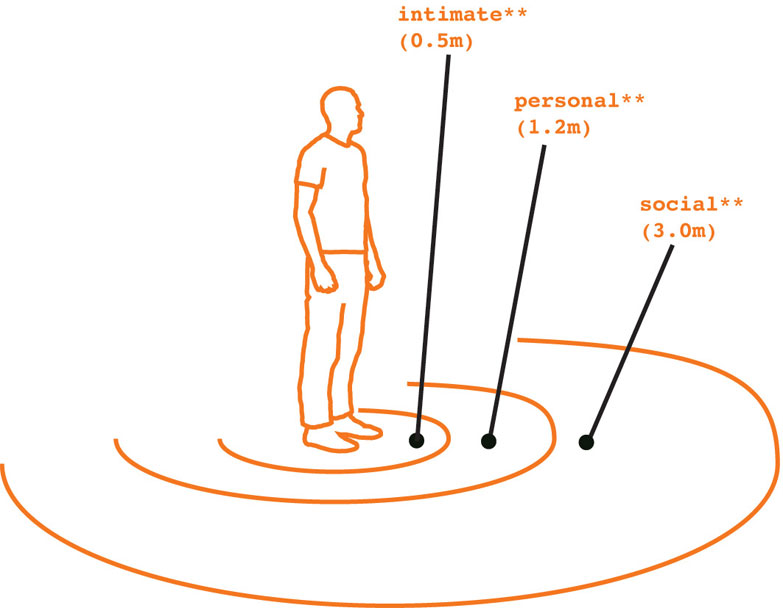
Causes of Conflict
Most psychology books suggest that conflicts come from two tendencies: approach and avoidance. To approach is to have a tendency to do something or to move in a direction that will be pleasurable and satisfying. To avoid is to resist doing something, perhaps because it will not be pleasurable or satisfying. These two categories produce three kinds of conflicts:
Approach-Approach Conflict - this is due to the pursuit of desirable but incompatible goals.
Approach-Avoidance Conflict - here is a desire both to do something and not to do it.
Avoidance-Avoidance Conflict - here there are two alternatives, both of which may be unpleasant.
Other causes of conflict are:
- A lack of communication,
- A lack of understanding,
- Ambiguous lines of authority,
- Conflict of interest,
- Disagreement on issues,
- The need for agreement,
- Generational differences, x Religious disagreements,
- Diversity in perspective,
- Majoring in minors,
- Environment and a lack of relationships.
Myths About Conflict

Defining Conflict Levels
Conflict can be experienced in three ways:
- Intra-personal conflict (when a person has internal conflict);
- Interpersonal conflict (when personalities clash); and
- Substantive conflict (disputes over facts, values, goals and beliefs).
Level 1: Facts or Data – This level of conflict occurs when two parties simply have different information. This is the easiest kind of conflict to resolve. To resolve this conflict leaders simply ensure that both parties have the same information.
Level 2: Processes or Methods – This level occurs when there is a difference of opinion over how things should be done. Because the issue here is “how do we get there?” rather than “where should we go?” compromise is usually a realistic option.
Level 3: Goals or Purpose – On this level parties cannot agree on a common goal. Negotiations at this level take patience and skill. Often youth leaders withdraw from this kind of conflict because they are not of the temperament to work through the hard issues and avoid the uncomfortable dialogues that accompany the resolution of conflict at this level.
Level 4: Values – The deepest and most serious conflict relates to values – the parties disagree about basic meanings. Any resolution at this level is almost impossible.
Defining the level of conflict can lead to the selection of appropriate responses to conflict resolution. But often what leaders think is the level is just a screen for a deeper level of conflict. One situation may include several different levels of conflict.
Conflict Handling Styles
As with leadership styles, different writers present models of conflict handling style and it seems that there is not a best conflict handling styles but a best style for a given situation. A few models will be considered, together with an indication of when the style is most appropriate:
Model 1 - Here we can distinguish between five styles
The Problem Solver – refuses to deny or flee the conflict, presses for conversation and negotiation of the conflict until a satisfactory conclusion is reached. Most effective with groups that share common goals and whose conflict stems from miscommunication.
The Super Helper – they constantly work to help others and give little though to self. This is the ‘Messiah’ who is often passive in their own conflicts but always assists others to solve their conflicts. This style is to be avoided as one must deal with personal conflicts to effectively help others.
The Power Broker – For this person, solutions are more important than relationships. Even if a person leaves the group, as long as a solution was achieved, they are satisfied. It can be used when substantive differences are so contradictory that mutually inclusive goals are not possible.
The Facilitator – they adapt to a variety of situations and styles in order to achieve a compromise between competing factions. It is effective for conflicts where differences are attitudinal or emotional.
The Fearful Loser – this person runs from conflict probably because they are personally insecure. This tends to produce hostility and a weakening of leadership in the group.
Conflict Transformation
Persuading – trying to change another’s point of view, way of thinking, feelings or ideas. Techniques used include: rational approaches; deductive and inductive arguments; and other verbal means. Persuade when there is great trust; when one party is admired; when goals are compatible; and when one party does not have strong opinions on the subject.
Compelling – the use of physical or emotional force, authority or pressure to oblige or constrain someone to act in a desired way. Use compelling infrequently; when you are threatened or under attack; when rights are being violated; when you have authority to demand compliance; when there is inadequate time to work through differences; and when all other means have failed.
Avoiding – This is actually a category that combines four styles: avoidance (to evade or stay away from conflict); ignoring (act as if the conflict is not going on); fleeing (actively remove oneself from the arena in which conflict might take place); and accommodation (going along with an opposition to keep the relationship). Strategies include: procrastination; saying yes to requests but not acting on them; showing concern for the other without responding to the problem; resigning; and studying the problem with no intention of doing anything about it. Avoid this style when people are fragile or insecure; when they need space to cool down; when there is conflict on many fronts simultaneously; when differences are trivial; when parties are unable to reconcile differences; and when the relationship is unimportant.
Collaborating – This is a process of co-labouring with others to resolve difficulties that are being experienced. It is also called joint or mutual problem solving. Collaborate when people are willing to play by collaboration rules; when there is plenty time for discussion; when the issue lends itself to collaboration; where resources are limited and negotiation would be better; and when conflict and trust levels are not too high.
Negotiating – Also called bargaining, this involves collaborating with lower expectations. It is a process where both sides try to get as much as they can, realising there must be give and take. Where collaboration is a “win/win” strategy, negotiation is a “sorta-win/sorta-lose” strategy. Negotiate when there is something that can be divided or traded; when compelling is not acceptable and collaboration has been tried and failed; when all parties are willing to bargain; when the different parties have equal power; and when trust is high.
Supporting – Here one person will provide a support to the person who is experiencing conflict. It involves strengthening, encouraging or empowering one party so they can handle their difficulties. Support when the problem is the responsibility of someone else; when a party brings problems outside of your relationship with them; and when one party in the conflict is unwilling to deal with issues.
Click here to view a video that explains conflict management.
Tension Between Relationships and Goals
A third model focuses on the tension between relationships and goals in conflict handling. When a leader becomes engaged in a conflict there are two major concerns to deal with:
- achieving personal goals and
- preserving the relationship.
The importance of goals and relationships affect how leaders act in a conflict situation. Given these two concerns the following five styles of managing conflict are found:

Withdrawing – people with this style tend to withdraw to avoid conflicts. They give up their personal goals and relationships; stay away from the issues over which the conflict is taking place and from the people they conflict with; and believe it is hopeless to try to resolve conflicts. They believe it is easier to withdraw (physically and psychologically) from a conflict than to face it.
Forcing – people in this category try to overpower opponents by forcing them to accept their solution to the conflict. Their goals are highly important but the relationship is of minor importance. They seek to achieve their goals at all costs; are not concerned with the needs of other people and do not care if other people like or accept them. They assume that one person winning and the other losing settle conflicts. While winning gives them a sense of pride and achievement, losing gives them a sense of weakness, inadequacy, and failure. They try to win by attacking, overpowering, overwhelming, and intimidating other people.
Smoothing – for those who fall into this category, the relationship is of great importance, while their own goals are of little importance. They want to be accepted and liked by other people; they think that conflict should be avoided in favour of harmony and believe that conflicts cannot be discussed without damaging relationships. They are afraid that if the conflict continues, someone will get hurt and that would ruin the relationship. They give up their goals to preserve the relationship. They try to smooth over the conflict in fear of harming the relationship.
Compromising – people with this style are moderately concerned with their own goals and about their relationships with other people. They seek a compromise. They give up part of their goals and persuade the other person in a conflict to give up part of their goals. They seek a solution to conflicts where both sides gain something.
Confronting – people in this category highly value their own goals and relationships. They view conflicts as problems to be solved and seek a solution that achieves both their own goals and the goals of the other person in the conflict. They believe conflict improves relationships by reducing tension between people. By seeking solutions that satisfy both themselves and the other person they maintain the relationship. They are not satisfied until a solution is found that achieves their own goals and the other person’s goals and they want all tensions and negative feelings to be fully resolved.
Conflict Handling
There are two dimensions to handling conflict: prevention and management.
Prevent Conflict: Applying good management principles in ministry and building quality relationships with people will help to prevent or at least lessen conflict.
Manage Conflict: In spite of the best efforts at prevention, conflict does arise. The secret is to learn to cope positively with conflict, and not to see it as an enemy to peace, but an opportunity for growth in relationships.
The Conflict Resolution Process
Parties should be asked to describe recent disagreements. What were the issues, who were involved, and how was the conflict handled? What are the differences between conflicts that were handled efficiently and those that were not? Can you see conflict styles evolving? With answers to questions like these the parties will be ready to work on clarifying goals, reconciling differences, and finding ways to resolve conflicts.

Clarify Goals
When people are in conflict they usually share many of the same goals despite their differences. Both sides usually want to see the conflict resolved in a way that will be mutually agreeable, beneficial to both, and inclined to enhance the relationship so that future communication will improve. The youth leader should try to discourage bargaining over positions and work from the basis of the common goals that people are striving for. People should first be reminded of the goals that they share, and then their differences discussed.
Reconcile Differences
The guidelines for reconciling differences are:
Step 1: Take the initiative and go to the person who has wronged you This should be done in person and in private. In making this move, it is best if the person goes with a spirit of humility, with a willingness to listen, with a determination to be non-defensive and to forgive.
Step 2: Take witnesses If the person will not listen or change, a return visit with one or two witnesses becomes necessary. These people are to listen, evaluate, determine facts and try to arbitrate and bring a resolution to the dispute.
Resolve Conflicts
When individuals or groups are in conflict, they have four main choices about the direction they will take. They may avoid conflict, maintain, escalate, or reduce it. Sometimes people do not want conflict resolution and may decide to go in different directions.
Conflict resolution will involve the youth leader in negotiation and mediation. It is not always wise for leaders to get involved in someone else’s conflict even when they are asked to do so, as they will feel pressurised to take sides; be required to make quick analytical decisions; and be responsible for keeping communication open.
When youth leaders do choose to get involved they should try to: show respect for both parties; understand both positions without taking sides; reassure people and give them hope; encourage open communication and mutual listening; focus on things that can be changed; try to keep the conflict from escalating; summarise the situation and positions frequently; and help the parties find additional help if the mediation is not effective.
We propose that you use the following four-step method in conflict resolution:
Step 1: Separate the people from the problem
This means treating one another with respect, avoiding defensive statements, or character judgments, and giving attention instead to the issues. Each side should be encouraged and helped to understand the other’s fears, perceptions, insecurities and desires. Parties should think of themselves as partners in a side-by-side search for a fair agreement, which is advantageous to each side.
Step 2: Focus on the issues, not the positions
When people identify the real issues, and stop trying to defend rigid positions they are on their way to resolve their conflict.
Step 3: Think of various options that might solve the problem
In the beginning there is no attempt to evaluate the options or to arrive at a single solution. Each side makes suggestions in a brainstorming session. After many creative and perhaps new alternatives have been proposed, each option can be evaluated.
Step 4: Insist on objective criteria
Conflict is less likely to occur if both sides agree beforehand on an objective way to reach a solution. If both sides agree to abide by the results of a coin toss, a judge’s ruling, or an appraiser’s evaluation, the end results may not be equally satisfying to both parties but everybody agrees on the solution because it was determined by objective, fair and mutually accepted methods.
